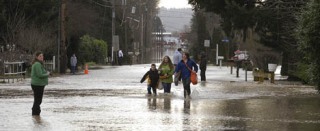The U.S. Army Corps of Engineers’ classified it as “nuisance flooding,” but it was a miserable ordeal for Pacific Mayor Richard Hildreth and many citizens.
A nasty January storm brought plenty of floodwaters, pain and anguish to about 1,200 residents – a fifth of the city’s 6,000 strong – who had to evacuate their homes and apartments, many filled with as much as 10 feet of water.
Pacific then resembled Fargo, N.D., now – a cesspool.
In a matter of hours, Pacific was inundated with stormwater, mud, debris and even sewage as Hildreth, rescue teams and volunteers scrambled to assist neighbors, conduct evacuations and sandbag the levee along the White River that spilled over its banks.
“It was difficult. I got very little sleep. It was a very stressful situation,” Hildreth recalled. “Even though my house wasn’t flooded, I saw other houses being flooded. I took it personally.”
The disaster stemmed from the Corps’ decision to release water from the swollen Mud Mountain Dam, a reservoir upstream built to control the Puyallup and White rivers.
The release was necessary to ease stress on the earthen dam and to make room for incoming water over the next few days.
Corps and city officials didn’t expect such a release would lead to severe flooding.
But it did.
The Corps admitted responsibility for the flooding.
Hildreth said no one was at fault and wasn’t angry at the Corps for releasing the water. That’s better than having the dam break, he said.
Still, the damage was done. And lessons were learned.
Jerry Miller, a legendary guitar player, lost irreplaceable memorabilia at his home. A woman’s vintage car sat in her garage, immersed in water. Other homeowners sustained major damage to their foundations.
All told, more than 100 homes, nine fourplexes and seven businesses were damaged. Of those homes, 60 were outside the flood plane.
Although the official amount is still being tabulated, Hildreth said the floodwater caused between $25-30 million in damages.
Pacific remains in recovery.
The Corps has put in a temporary levee. King County has been asked to scalp the gravel along the river’s channel.
Corps, county and local officials are working to improve communication in the event of a similar episode.
Residents, meanwhile, have reached out and received federal aid. Many households are getting back on their feet, proving to be most resilient in the hardest of times.
“I’ve been overwhelmed with pride in how everybody pulled together,” Hildreth said.
In the aftermath, there was plenty of blame to go around. Not all went well. There was miscommunication among officials responsible for handling a flood situation. There were delays. There were missteps.
Many things went right. A shelter and aid station, with volunteer support, sprang into action. Evacuations, for the most part, went well. Looting was limited.
Despite the mess, Pacific survived, in part, because of emergency preparedness. Such a plan saved the city from even more problems, Hildreth contends.
“A disaster will happen,” he said. “The better the plans in place, the better the chances to recover.”
Hildreth knows plenty about emergency preparedness. He has devoted considerable time and focus on the subject. He has helped Pacific write one of the best emergency preparedness plans in the state.
He recently graduated from the Master Exercise Practitioner Program in Upstate Maryland, considered one of the highest levels of disaster exercise training in the country, according to the Federal Emergency Management Agency.
Recognizing his leadership in the area, Gov. Christine Gregoire appointed Hildreth to serve on the Washington State Emergency Management Council.
Lately, Hildreth is spreading the word by urging cities, businesses, even the smallest of groups, to devise, follow and practice an emergency preparedness plan.
He hopes more individuals, groups and partners will seriously come up with a plan, especially in an area prone to flooding, earthquakes, power outages and other damages caused by savage storms.
“We are vulnerable,” Hildreth said. “Think about how likely it is to happen and how you can prepare for it. Ask yourself, ‘How will you be affected by this? How will it affect your business?
“I’m trying to reach out to better help people and stress the importance of being prepared,” Hildreth said.
There are resources out there to help. Cities have emergency response personnel to assist in planning. Community training courses, such as CERT programs, are available.
He also urges homeowners to obtain flood insurance.
“I’m not here to save business, but to ask those to have a plan in place, to think what to do in the event of a natural disaster,” Hildreth emphasized.
The goal, as Hildreth says, is to get others to think about emergency preparedness, “so that emergencies don’t grow into disasters and disasters don’t grow into catastrophes.”
Like the one in Pacific nearly three months ago.
“I don’t want to see that happen again,” Hildreth said.



